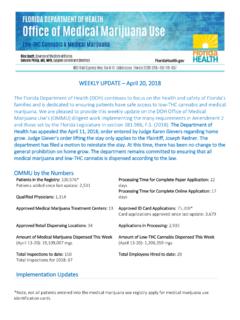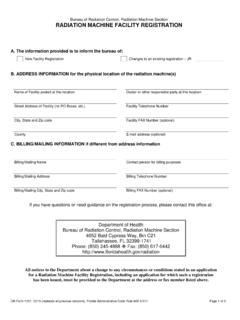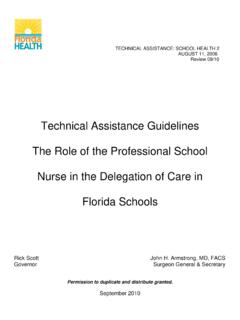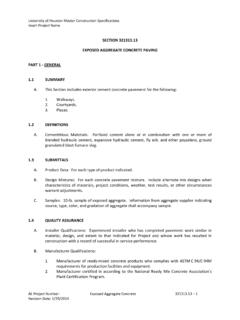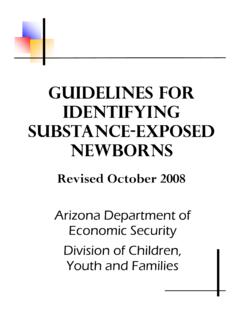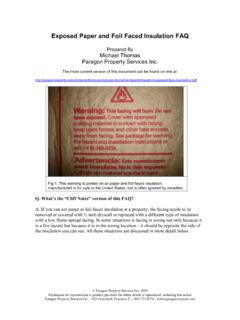Transcription of Chapter 12: Substance Abusing Pregnant Women, Substance ...
1 155 Chapter 12: Substance Abusing Pregnant women , Substance exposed Children and Their Families Introduction Substance abuse includes the abuse of alcohol, tobacco and other drugs. Prenatal Substance abuse has a clear impact on the health of the Pregnant woman. Prenatal drug abuse and the woman s lifestyle that often accompanies drug abuse may affect fetal development, the infant s birth weight, mortality and the child s future development. Based on combined responses to the 2004 and 2005 National Surveys on Drug Use and Health: National Findings percent of Pregnant women acknowledge that they used an illegal drug during pregnancy. Ten percent of women aged 15 to 44 who were not Pregnant used illegal drugs. For more information on the impact of various drugs, go to Tobacco use is addressed in Chapter 10 of this document. This Chapter ( Chapter 12) addresses Healthy Start care coordination for Pregnant women who use alcohol, or abuse other drugs, Substance exposed children and their families.
2 Definition of Service Healthy Start care coordination is initiated for Substance Abusing Pregnant women and Substance exposed children and their families. All of these families are expected to be referred for Healthy Start care coordination. Identification of use/abuse of alcohol and/or illegal substances is determined as follows: EITHER a woman who has abused schedule I or II drugs during pregnancy or postpartum, as documented by Her own admission A positive drug screen A staff member witnessing the use A report from a reliable source such as a trusted family member or professional. Response to screening questions indicating use or abuse Further observations or assessment of Substance abuse history and patterns of use OR an infant who was prenatally exposed to schedule I or II drugs, as documented by the above criteria. (A list of schedule I and II drugs can be found in , , >2008->Ch0893->Section%2003# ) Healthy Start Standards & Guidelines 156 Standards and Criteria The standards outlined in this section relate to services provided to: Pregnant women who have abused drugs during a previous pregnancy; Pregnant women who have abused drugs within one year of this pregnancy; Pregnant women who abused drugs during current pregnancy including prescription and non-prescription drugs; Pregnant women who are drinking alcohol during this pregnancy; Pregnant women with a history of alcohol abuse; Children prenatally exposed to or demonstrably adversely affected by alcohol abuse; Children prenatally exposed to or demonstrably adversely affected by schedule I or II drugs; Other caregivers of these children; and their families.
3 Standard The Healthy Start coalition will collaborate with county health department(s), the local child protection team, providers of Healthy Start services, prenatal and pediatric care, the local Children s Medical Services providers, Healthy Families Florida, Substance abuse treatment providers, and the local Department of Children and Families and their contracted providers, hospitals and birth centers in forming interagency agreements to ensure coordinated, multi-agency assessment of and intervention for the health, safety, and service needs of women who abuse alcohol or other drugs during pregnancy, and of Substance exposed children up to age three. The agreements will include private organizations receiving funding from the above organizations. Criterion: There is a district operating procedure or letter of agreement with the above agencies that complies with the letter of agreement signed by the Department of Health and the Department of Children and Family Services.
4 Standard All providers receiving Healthy Start funding to provide prenatal care will educate women about the dangers of using alcohol or other drugs, conduct verbal screening for Substance abuse, and refer for Substance abuse treatment when Substance abuse is identified. Criterion: Prenatal care provider s records reflect documentation of education about the dangers of Substance abuse during pregnancy, verbal screening for Substance abuse, and appropriate referrals and interventions. Drug toxicologies may be done at the provider s discretion with the client s informed consent. Chapter 12: Substance Abuse and Exposure Revised April 2009 157 Standard Pregnant Substance Abusing women will be enrolled in Healthy Start care coordination services. Criteria: The participant s record reflects documentation of enrollment in Healthy Start care coordination or persistent attempts to engage the woman in Healthy Start.
5 Note: A Pregnant Substance Abusing woman is to be considered as a care coordination level three until information received indicates otherwise. Once the woman is receiving Healthy Start care coordination, the participant s record reflects documentation of the following: Education about effects of alcohol and other drug abuse on mother and infant; Verification of whether the woman is or is not getting drug treatment or referral to drug treatment and follow-up; Assessment of progress towards abstinence at each visit, provision of support, and referrals as appropriate; Discussion of future family planning steps and referral for family planning if desired; Assessment of adequacy of the physical home environment for mother and the new baby; Identification of services needed, referrals for needed services, and follow up on referrals to assess outcome and need for further assistance in linking with needed service.
6 Ongoing assessment of the safety, health, and developmental status of children in the home and educating the mother and caregiver about ways to promote child health, safety and development; Progress on or a completed Family Support Plan; Ongoing coordination with other service providers. Standard The county health department is notified by hospitals and other birthing facilities of all infants prenatally exposed to abuse of prescription and non-prescription drugs. Criterion: The coalitions will ensure hospital staff is aware of the responsibility, in accordance with , , to identify and refer for Healthy Start services all infants prenatally exposed to abuse of prescription drugs and illegal substances. Standard The Healthy Start care coordinators report Pregnant Substance Abusing women and infants prenatally exposed to alcohol or illegal drugs to the Department of Health. Criterion: The Healthy Start care coordinator documents services to women who have abused illegal drugs during pregnancy and services to children prenatally exposed to illegal drugs using guidance provided in Chapter 14: Healthy Start Coding.
7 Healthy Start Standards & Guidelines 158 Standard All Substance exposed children will receive Healthy Start care coordination whether or not the child received a positive score on the Healthy Start infant (postnatal) risk screen or was reported to the Florida Abuse Hotline. If the current caregiver1 is not the biological mother, the caregiver has the authority to consent to Healthy Start participation. Criteria: 12. The participant s record reflects documentation of Healthy Start care coordination services or documents inability to provide them. Note: A Substance exposed child is to be considered as a care coordination level three until information received indicates otherwise. Standard A home assessment will be completed prior to hospital discharge of a Substance exposed newborn, or record will show why the assessment was not completed at that time. Criteria: The participant s record reflects documentation of a comprehensive home assessment and provision of parenting support services, including the following items.
8 A meeting with the birth mother and any other intended caregiver, if the mother will not be the primary caregiver, and a visit to the home of the mother/caregiver; An environmental and family assessment focused on the safety and quality of care that is or will be provided for the child, including: a) Health condition of the child; b) The mother and any other caregiver's ability to care for the child's unique needs in the home environment; c) Strengths and needs relating to family composition including dissentions in the family that may affect the child; d) Parenting capabilities of those persons in the home with primary child care responsibilities; e) The adequacy of the physical environment of the home; f) Identification of services needed; g) Education needs of the mother and caregiver for any special health-related care the child may require; h) Identification of the strengths of the mother, infant, and others in the home.
9 Identifying and responding to immediate family needs; Parent education, information and anticipatory guidance about normal growth and development, effects of prenatal and postnatal Substance exposure, child soothing techniques, and also feedback about mother/caregiver child interaction; Reinforcing previous information given about the effects of alcohol, tobacco and other drugs; Education on needs of the mother and caregiver for any special health-related care the child may require; Comprehensive health care service provision for the child, and for other children 1 Caregiver is the child s primary caregiver. The caregiver may be the biological mother, another relative, a foster parent or adoptive parent. Chapter 12: Substance Abuse and Exposure Revised April 2009 159 in the home, according to the Medicaid Child Health Check Up periodicity schedule; Referral for early intervention assessment or Children s Medical Services when the need for further developmental assessment or services are indicated; Verification that the mother is getting drug treatment or referral to drug treatment and follow-up; Support of the mother s steps towards Substance abuse abstinence including encouraging her to comply with Substance abuse treatment; and explaining the consequences of failure to comply with Substance abuse treatment, the family support plan, or the protective supervision case plan; Crisis intervention as appropriate; Providing feedback to other service providers.
10 Initiation of a family support plan with the family and other participating service providers; and Referral to needed services. The pre-discharge home assessment may be waived if the mother has participated in Healthy Start prenatal care coordination, and/or the care coordination provider has knowledge of the home situation, and has assessed it to be satisfactory. Documentation of the pre-discharge home assessment reflects items listed above. * See Chapter 4, Care Coordination and Risk Appropriate Care, Standard , for directions on charting information about persons other than the infant. Documentation reflects a home visit within three days of referral of a Substance exposed newborn in the event a pre-discharge visit is not possible due to brevity of hospital stay, failure to be notified of infant prior to discharge, attempted contacts, inability to locate, or other reasons for failure to comply with the standard criterion.

